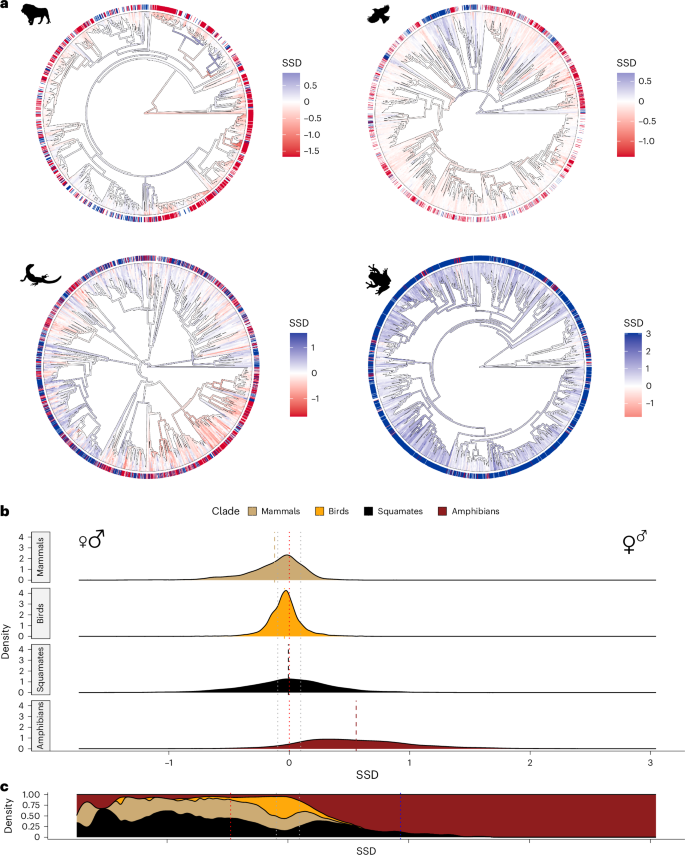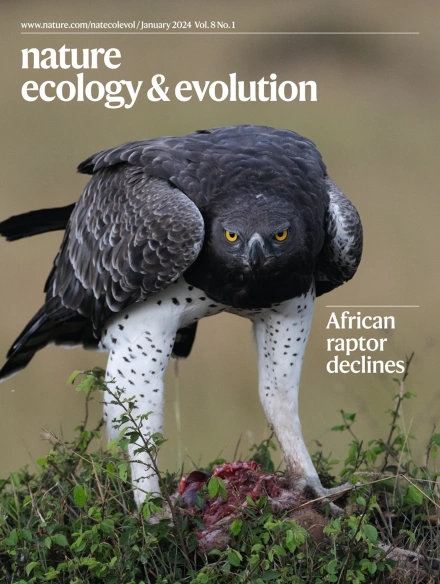Evolution of sexual size dimorphism in tetrapods is driven by varying patterns of sex-specific selection on size
IF 13.9
1区 生物学
Q1 ECOLOGY
引用次数: 0
Abstract
Sexual size dimorphism (SSD) is highly prevalent in nature. Several hypotheses aim to explain its evolution including sexual selection, differential equilibrium and ecological niche divergence. Disentangling the causal mechanism behind the evolution of SSD is challenging, as selection arising from multiple pressures on fitness may act simultaneously to generate observed patterns. Here, we use phylogenetic comparative methods to study the evolution of SSD across tetrapods globally. We estimate directional changes in body size evolution, and compare the number, phylogenetic position and magnitude of size changes between sexes. We find evidence that directional changes in size associated with SSD are typically more common in males—even in lineages where females are larger. However, underlying mechanisms differ among lineages—whereas SSD in amphibians becomes more male-biased with greater increases in male size and mammalian SSD becomes more female-biased with greater decreases in male size. Thus, differing mechanisms of directional body size evolution across sexes are essential to explain observed SSD patterns. A phylogenetic comparative analysis of male and female body size across tetrapods globally shows that directional change in size is usually greater in males but reveals different underlying mechanisms among lineages.


四足动物性别大小二态性的进化是由不同的性别特异性大小选择模式驱动的
性别大小二态性(SSD)在自然界中非常普遍。关于其进化的几种假说包括性选择、差异平衡和生态位分化。解开SSD进化背后的因果机制是具有挑战性的,因为适应性的多重压力产生的选择可能同时产生观察到的模式。在此,我们使用系统发育比较方法来研究全球四足动物SSD的进化。我们估计了体型进化的方向性变化,并比较了性别之间体型变化的数量、系统发育位置和幅度。我们发现有证据表明,与SSD相关的尺寸方向性变化在男性中更为常见——即使在女性体型较大的谱系中也是如此。然而,潜在的机制在不同的谱系中是不同的,而两栖动物的SSD随着雄性体型的增加而变得更偏向于雄性,而哺乳动物的SSD随着雄性体型的减少而变得更偏向于雌性。因此,不同性别的定向体型进化机制对于解释观察到的SSD模式至关重要。
本文章由计算机程序翻译,如有差异,请以英文原文为准。
求助全文
约1分钟内获得全文
求助全文
来源期刊

Nature ecology & evolution
Agricultural and Biological Sciences-Ecology, Evolution, Behavior and Systematics
CiteScore
22.20
自引率
2.40%
发文量
282
期刊介绍:
Nature Ecology & Evolution is interested in the full spectrum of ecological and evolutionary biology, encompassing approaches at the molecular, organismal, population, community and ecosystem levels, as well as relevant parts of the social sciences. Nature Ecology & Evolution provides a place where all researchers and policymakers interested in all aspects of life's diversity can come together to learn about the most accomplished and significant advances in the field and to discuss topical issues. An online-only monthly journal, our broad scope ensures that the research published reaches the widest possible audience of scientists.
 求助内容:
求助内容: 应助结果提醒方式:
应助结果提醒方式:


